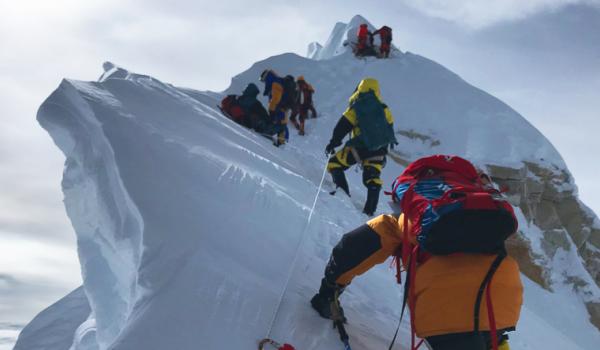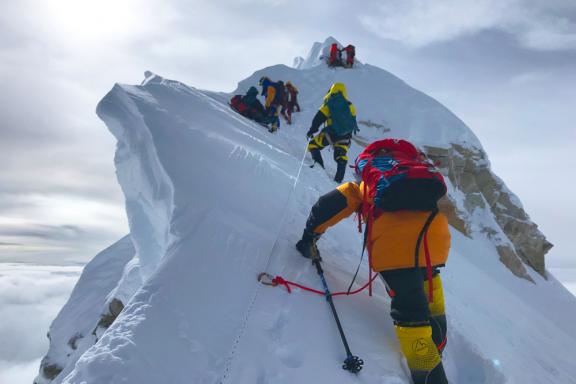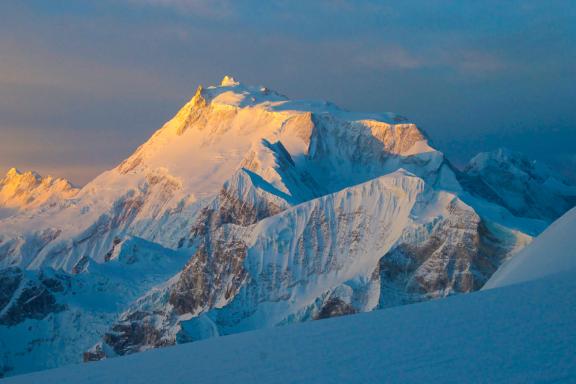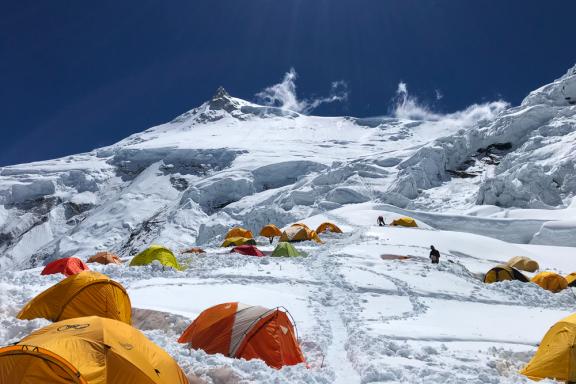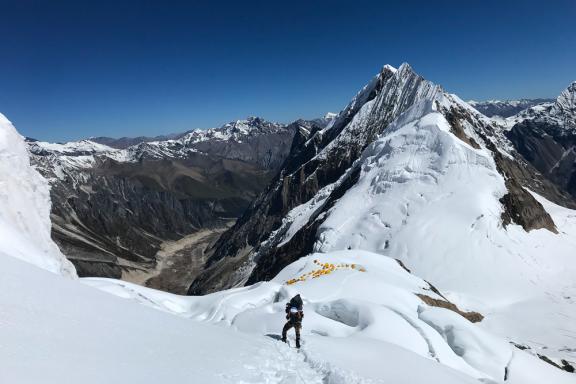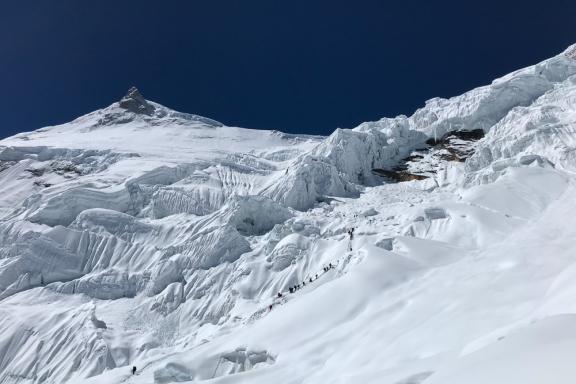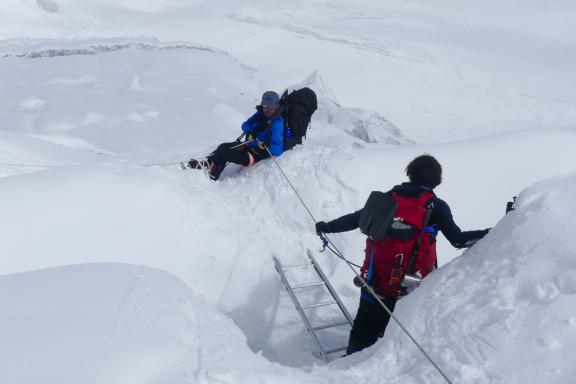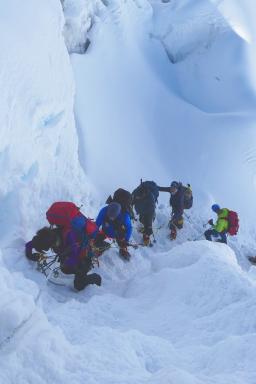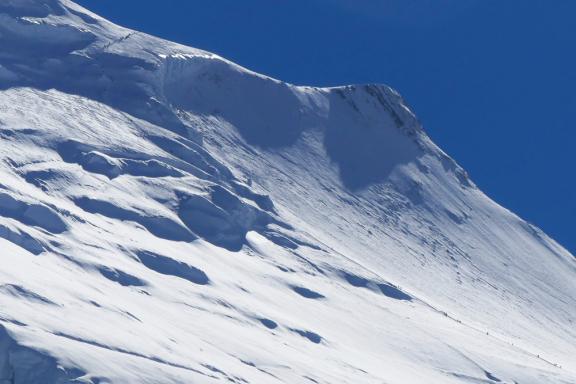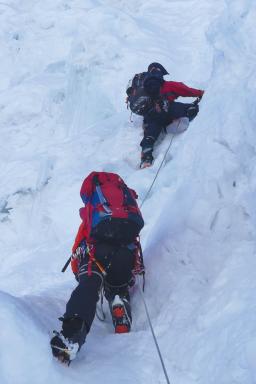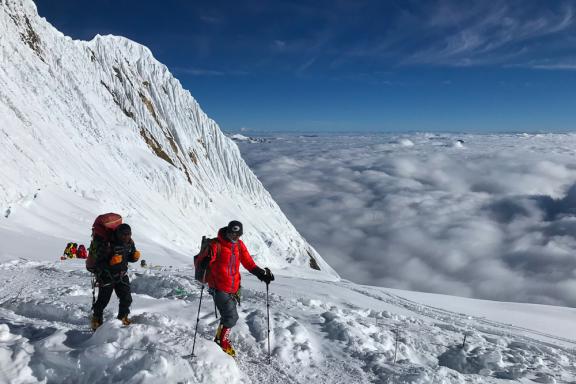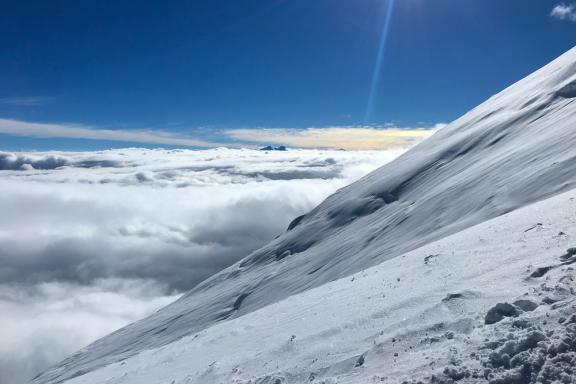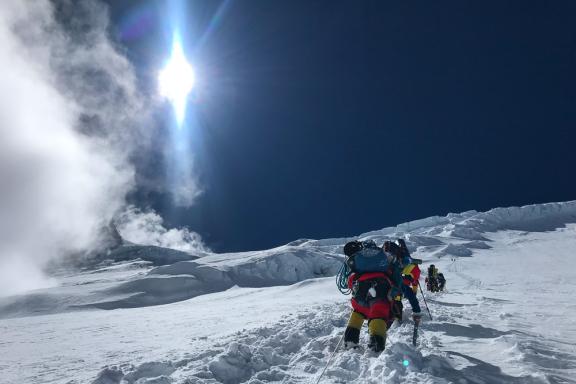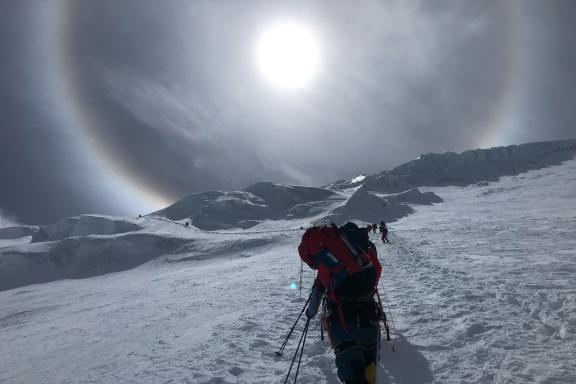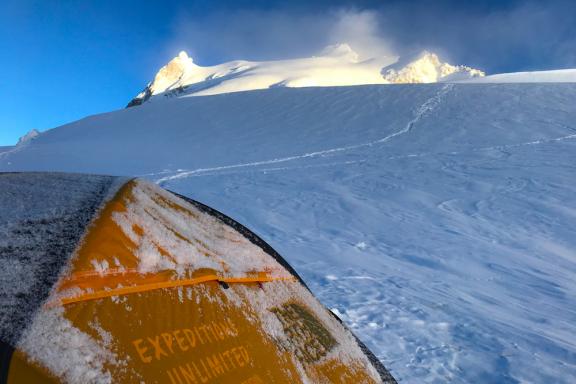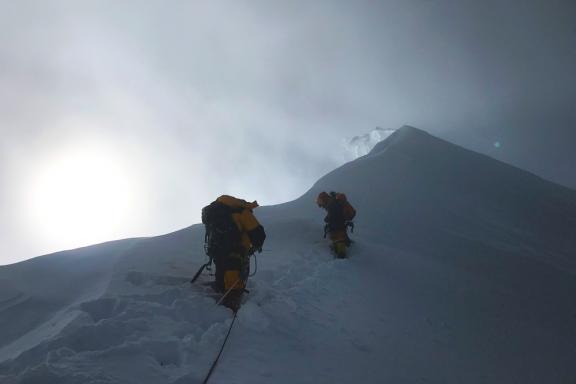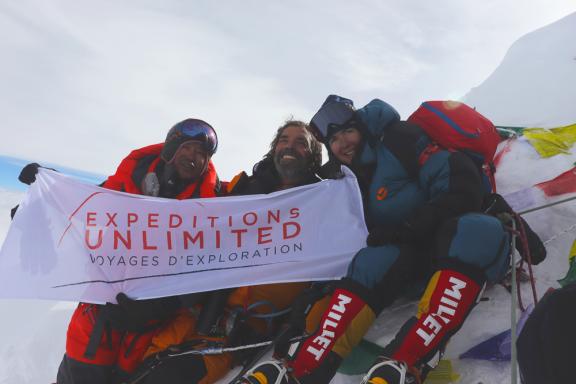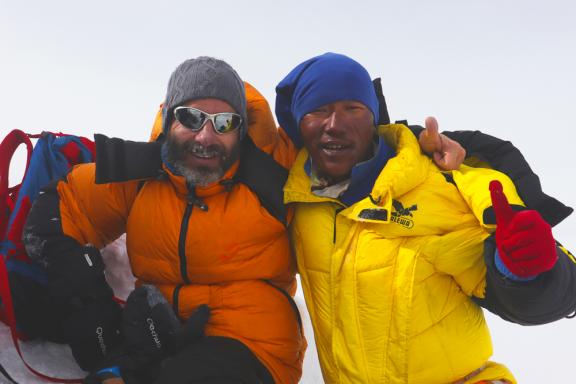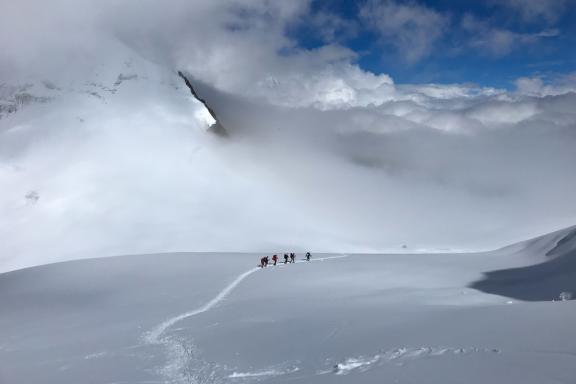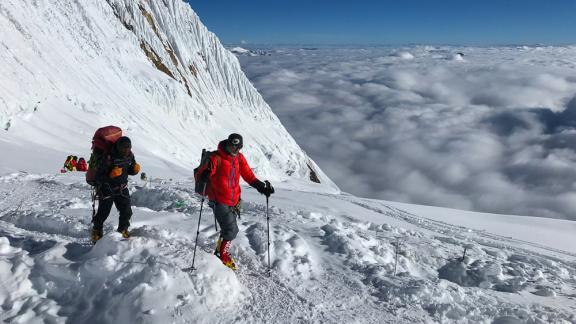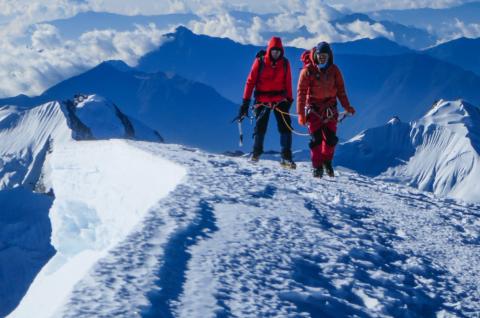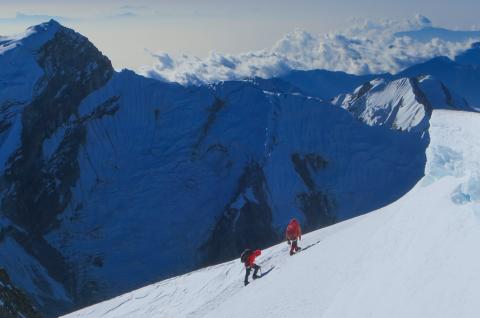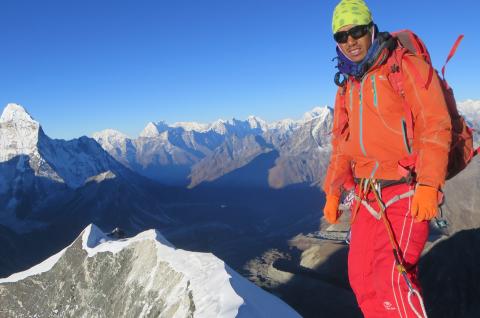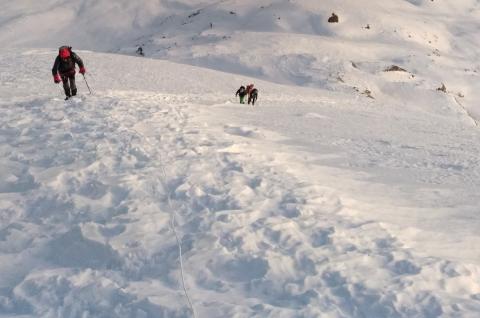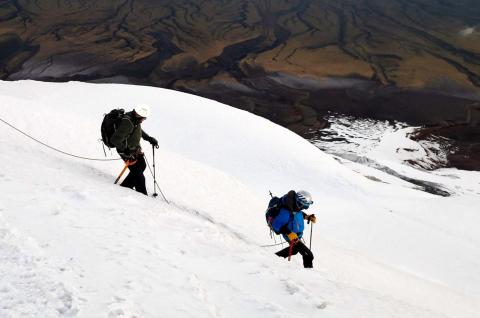A mythical 8000er relatively accessible
Highlights
- Ratio of 1 guide to 1 participant
- Expedition leader also UIAGM guide
- Ascent with or without oxygen supply
- Access to base camp in trekking
- H24 weather forecast and medical hotline
- Preparation course, live expedition coverage
- Guaranteed departure from the first participant
- Permit included for US$3,000 as of 01/09/25
For many mountaineers, the mythical 8000-meter mark is a goal, the dream of a lifetime. Our Manaslu expedition offers the best possible chance of success. Its relatively low technical difficulty means that we can concentrate on all the components of life at altitude. But we must not underestimate the sheer scale and effort required to reach the summit. We entrust the organization of the ascent to an experienced expedition leader, and our local teams know the Manaslu well, having organized several previous expeditions there. An extraordinary immersion and adventure. Read the diary of our successful expedition in autumn 2021, in which one participant reached the summit without supplemental oxygen.
Overview
See pictures of our Manaslu expedition in autumn 2021.
Manaslu, at 8163 meters, is a great mountain, the eighth 8000-meter peak on the planet. Its Sanskrit name, Manasa, is imbued with poetry, and can be translated as "mountain of the spirit" or "refuge of the soul". Quite a program...
Away from the main tourist routes and close to Tibet, the Manaslu massif has preserved a very special character, combining pastoral life and traditions. The Manaslu circuit trek has become a benchmark in the small circle of major treks in Nepal, and the process of "turning it into a tourist attraction" continues apace. Its reputation is justified by the beauty of its landscapes, the diversity of its villages and cultures, and its emblematic summit of rare aesthetic appeal.
Climbing Manaslu is technically accessible (PD in snow) for mountaineers. However, like all ascents of the highest Himalayan peaks, it remains a major undertaking. Not to be underestimated. Manaslu is less popular in spring than in autumn, as most expeditions are to Everest, which can be both an advantage and a disadvantage.
In spring, there are fewer people at base camp and on the mountain, less pollution and therefore less stress, but above all fewer teams to rely on, both morally and logistically. Most of them are employed on the slopes of Everest at this time of year. With the Indian plains so hot, the weather is more unstable than in autumn. The monsoon arrives in late May and early June, and lasts until late August.
In autumn, the weather is more stable, as it is colder after the monsoon. Snow conditions are more favorable (crevasses blocked by snow). Nepalese teams are more readily available. From the end of October, the jet-stream (a strong high-altitude wind) sets in, heralding the onset of winter.
It is a big mountain, and there's plenty of room to live together. The route is also suited to "gentle progress", with numerous high-altitude camps. Our Nepalese team will be as close to us as possible, making a major contribution to the success of our adventure.
Like many 8000-meter peaks (Annapurna, Shishapangma, Dhaulagiri,...), Manaslu has a true summit (the highest point, sometimes exposed, sometimes very exposed) and a false summit, a little lower down, often admitted in the tolerance zone of a "realized summit". A recent well-documented study by Eberhard Jurgalski tends to show that, in the end, few climbers, even the greatest, seem to have reached the true summit of certain 8000... In the case of Manaslu, we can stop at the snow stage, which is a flat area (8156 m) before the true summit, considered to be the summit acquired. The true summit is thirty meters further and seven meters higher (8163 m). Sometimes you have to wait for the summit, which only admits a few people, which, with the wind and the cold, can be an unpleasant experience. In addition, the real summit is on a wind-made ledge, so there's always a bit of risk in climbing it, especially with the snow in autumn.
It is a real journey to altitude that we are proposing. A journey of slowness and restraint, to cultivate the pleasure and happiness of being "up there". A unique and exceptional journey.
Discover our animated itinerary of the Manaslu ascent.
MOUNTAINEERS' WORDS
These words of mountaineers, collected for the ascent of Everest, apply perfectly to our ascent of Manaslu.
“So what is it that makes this summit so fascinating to all mountaineers?... It is the highest mountain in the world... The many expeditions and the men who have conquered it have not succeeded in making it smaller. The altitude remains.“ - Reinhold Messner
“We didn't have to wait for the ultimate vision. Above the fog, Everest was still before us...: motionless as Keats star in its solitary splendor, and so high in the night! Eternal watchman of the shadows, the Mount seemed to intoxicate the world with its radiance.” - George Leigh Mallory
“Suddenly, it occurred to me that the ridge in front of us, instead of continuing to rise, was falling sharply; much lower down, I could see the North Col and the Rongbuck Glacier; in the foreground, a narrow snow ridge climbed towards a snowy summit; a few more ice axe strokes in the hardened snow... and we were at the summit. It was 11:30 a.m.” - Edmund Hillary May 29, 1953.
COLLECTIVE ADVENTURE
Our expedition will be a collective adventure, a crossroads of motivations and energies, a meeting of the capacities of an organization and motivated mountaineers. Two parallel challenges will have to be met:
- for the participant: to be at the top of his physical, technical and mental level when need be;
- for the organizer: to provide impeccable logistics enabling access to the high altitude camps under optimum conditions. Beyond that, it is up to the participants to make their own way up the summit ridge.
The main objective of this expedition is to experience an adventure that requires total commitment, both physical and moral, acting with lucidity and humility in a hostile natural environment that forgives no imprudence or temerity at the risk of death. It is this testimony that must be wisely recounted.
Good observance of all safety rules is essential, as is good physical and psychological preparation, a warm and supportive environment, total serenity, a little tactics and then, if the weather is kind and luck is on our side, we will be able to count down the magic minutes at the summit when effort ceases and nothingness fills the space and instills itself within us.
All parties agree that giving up does not constitute failure. Returning can also be a victory over oneself. Any preparation, even the most meticulous, any will, even the most tenacious, can be defeated by the adversity of natural environments whose strength is exponentially stronger than the finest human intelligence. Let the gods bless us and allow us to tread the summit.
OUR MOTTO IS: DARE TO CLIMB, KNOW HOW TO DESCEND
VERY HIGH ALTITUDE
Advice from Hubert Giot, mountain guide. He has taken part in several expeditions to 8000 meters and climbed Everest without oxygen.
It is not easy to establish rules, because mountaineers are not equal when it comes to altitude, either physiologically or mentally. Everyone seems to have their own plateau where they get stuck. Extremely tiring, this stage is always painful, but not prohibitive. Once you are past this stage, everything is fine... or not so bad. It is generally at this point that you get a better idea of your ability to adapt. This can happen as early as 6000 meters, or even earlier, during the approach trek.
High altitude also has its own rules, and transgressing them becomes inherently dangerous. There is a fundamental difference between climbing to 8000 meters and descending immediately, and staying there for 12 or 24 hours.
At this altitude, the trouble really starts, and every minute spent up there brings with it an inexorable process of self-destruction. We experience loss of sleep, lack of appetite, apathy and often hallucinatory phenomena.
In short... above 8000 meters, you are consumed. For novices, anything is possible, just remember a few basic rules. The first few days at base camp serve as a thermometer, and by the end of the third day you are often starting to feel good. It is then up to you to decide how to divide up the stages: you can either use the usual camp sites, or those defined by the terrain. As a general rule, when you can sleep at 6500 meters without headaches, you are ready to go higher. However, it is a good idea to make return trips to 7000 or 7500 meters, to test your potential. During these essential phases, it is important to stay well hydrated. Now it is time to spend an often uncomfortable night at around 7500 meters, then attempt the summit at 8000 meters. If the summit is beyond that, we try to sleep at 8000.
As for the rest, you need to be prepared to use your brain (or what is left of it) rather than your muscles, because meters, beyond 8500 meters, are expensive. And if I say brain, it is because it needs to be sufficiently alert to decide when to descend. If it does not, it is certain death. Doing an 8000er in good conditions is tough, but with cold, wind, snow or a barometric depression, it turns into a nightmare.
As a general rule, there are a few precautions to take:
- don't get too cold;
- don't get too hot;
- cover your head;
- stay hydrated, even in bad weather;
- try to have one hot snack a day;
- during the trek, do not walk bare-chested;
- at high altitudes, keep an eye on each other; don't doze off together;
- never descend alone;
- set limits for yourself, and look out for signs such as mirages, falling asleep and total loss of appetite;
- never hesitate to turn back, whatever the pressure;
- and in all cases, accept the fact that the mountains will always be there.
In short, to evolve at high altitude, you need meticulous preparation, adequate acclimatization, constant and mutual verification, intellectual vigilance at all times, and immediate renunciation in the event of weakness, doubt or danger.
Take a look at our web-conference on climbing Everest and Manaslu.
Itinerary
Day 0
- Days 1 & 2: International flights to Kathmandu
- Day 3: Kathmandu
- Days 4 & 5: Kathmandu – Besisahar – Goa
- Day 6: Goa – Chauli Kharka
- Day 7: Chauli Kharka – Bimthang
- Day 8: Bimthang
- Days 9: Bimthang – Larkya Pass – Dharamsala or Samdo
- Day 10: Dharamsala or Samdo – Sama
- Day 11: Sama – Manaslu Base Camp
- Days 12 to 37: Ascent of Manaslu (8163 m)
- Day 38: Manaslu Base Camp – Sama
- Day 39: Sama – Samdo
- Day 40: Samdo – Middle camp
- Day 41: Middle camp – Larkya La – Bimthang
- Day 42: Bimthang – Tilje
- Day 43: Tilje – Dharapani – Kathmandu
- Days 44 & 45: International flights
EXPEDITION DETAILED PROGRAMME
DAYS 1 & 2: EUROPE — KATHMANDU
Day 1
Flight from Europe to Kathmandu. Arrival is usually on Day 2. Welcome by our local team at the hotel and free time.
DAY 3: KATHMANDU
Day 3
DAYS 4 & 5: KATHMANDU — BESISAHAR — GOA
Day 4
DAY 6: GOA — CHAULI KHARKA
Day 6
A gentle start to the trek, as we soon cross a major pass at over 5000 meters.The valley becomes increasingly alpine, with beautiful forests and, in a clearing, our evening lodge, Chauli Kharka.
DAY 7: CHAULI KHARKA — BIMTHANG
Day 7
We continue along the river to Kanigaon and Khola Bensi, with occasional views of the Ganesh Himal peaks and the Machha Khola valley.We soon reach Tatopani, on the same bank of the river, where there is a hot spring. We then cross the Budhi Gandaki on a suspension bridge to reach Dobhan (1300 m). The Budhi Gandaki valley narrows before reaching Jagat.
DAY 8: DAY AROUND BIMTHANG
Day 8
A customizable day to acclimatize. Either trek to Ponkar Lake or a new base camp on the western side of Manaslu, or simply enjoy the surroundings.
DAY 9: BIMTHANG — LARKYA PASS (5150 M) — DHARAMSALA OR SAMDO
Day 9
Since the earthquake, access to the upper Nubri valley with the villages of Samdo and Sama has been via the Larkya Pass (5150 m), now regularly used by muleteers from both valleys. It is over this pass that our expedition equipment will pass. On the other side, we set up camp between Dharamshala and Samdo.
Elevation change: +1450 m/-750 m for Dharamsala or -1350 m for Samdo (over 2 days)
DAY 10: DHARAMSALA OR SAMDO — SAMA
Day 10
A leisurely descent to enjoy the high valley at the foot of Manaslu. Meanwhile, the Nepalese team will have organized the transport of our equipment to base camp, using local porters. A particular local rule that we respect by not using a helicopter, unlike many teams who even make the trip directly from Kathmandu.
Number of trek hours: 3 hours from Samdo, 6 hours from Dharamsala
Difference in altitude: +50 m/-400 m from Samdo; +100 m/-1000 m from Dharamsala
DAY 11: SAMA — MANASLU BASE CAMP
Day 11
A long climb that is hard to do any other way. The start is early, the route over the lake particularly aesthetic, and our kitchen team awaits us directly at base camp at 4850 meters. We are "home" for the mountaineering part of our high-altitude journey.
DAYS 12 TO 37: ASCENT OF MANASLU (8163 M)
Day 12 to 37
For this Manaslu ascent, we are planning 4 altitude camps.
Camp 1: 5900 m
The trek to Camp 1 from BC is easy, but long and shortens as acclimatization progresses (from 7 hours to 5 hours).
The final stretch to Camp 1 is a little steeper.
The route to Camp 1 involves climbing over grassy slopes, rocky slabs and a moraine, followed by a crevassed glacier that is reached an hour after leaving base camp. This is the time to put on crampons (crampons point), to climb the occasional small glacier ledge up to Camp 1 at 5900 meters. Depending on the season, there may be snow around and below base camp. The view of the surrounding peaks will add reference to the climb, and the team will enjoy seeing more of the upper part of the mountain.
Camp 2: 6400 m
The route to Camp 2 at 6400 meters is considered the technical part of the climb, with a crevassed glacier where fixed ropes ensure safety on the steepest sections. The terrain features long snow slopes inclined at 40/45 degrees, involving the crossing of a few sections of vertical ice, where progress is made on the front points of crampons, with the help of fixed ropes. To negotiate these short ice sections, you need to have perfected your fixed-rope technique using a self-locking handle, and to know how to use the front points of your crampons. Allow 5-7 hours between the two camps.
Camp 2 at around 6400 meters, at the end of a 40/45-degree snow slope, on a plateau.
Camp 3: 6800 m
Above Camp 2, the slopes diminish and the route to Camp 3 at 6800 meters may pose no difficulty, but this depends on the configuration of the glacier. In autumn 2021, there were two relatively vertical sections between Camp 2 and Camp 3, whose difficulty was equivalent to the sections climbed between Camp 1 and Camp 2, although not as long. This section takes around 3 to 4 hours to complete. Camp 3 is located at the pass, or better still, just below it, protected from the wind if snow conditions permit.
Camp 4: 7400 m
From Camp 3, it is a fairly leisurely start, then a 50-degree incline, rising to 70 degrees for 5 meters before Camp 4, at 7400 meters, slightly behind the ridge. All in all, the climb is rather arduous at the end, especially at altitude. It calls for a well-deserved rest and rehydration once we reach Camp 4. An attempt at the summit that evening.
On the way to the summit: 8156 m/8163 m
Departure usually between 11pm and 1am. Short night, light sleep. Camp 4 is the starting point for oxygen intake.
Progress is not very technical on the first part of the pre-summit plateau, as we climb from plateau to plateau, crossing a few short, steeper passages. The whole route is no more difficult than the ascent of the Dôme du Goûter in the Mont-Blanc massif.
A gradual climb, especially for those who attempt the summit without oxygen. Oxygen brings warmth to the body.
All day long, our teams of high-altitude sherpas are on the trail, doing their utmost to help the group on this memorable day whose goal is to reach the summit of the eighth highest mountain in the world!
Acclimatization strategy and rotations
Two acclimatization rotations are planned before the final summit push. Your expedition leader will decide on the number of rotations according to the level and fitness of the participants, the weather, oxygen intake, etc.
The scheme could be as follows:
First rotation
- 1-2 days rest at base camp (4900 m)
- Ascent to Camp 1 (5900 m) and two nights at C1, with incursion between C1 and C2, then return to base camp
Second rotation
- 1-2 days rest at base camp (4900 m)
- Ascent to Camp 1 (5900 m) and overnight at C1
- Ascent to Camp 2 (6400 m) and overnight at C2
- Climb to Camp 3 (6800 m) and overnight at C3 then return directly to base camp
- Climb to C3 to store food, thermos flask, change of clothes including socks, etc., in preparation for the summit push. For those who wish, and conditions permitting, we can touch 7000 meters, i.e. heading towards C4 for around 1 hour. Return to C3 (one night at C3). The results of this night at C3 often tell us more about the participant's fitness than the pace of their ascent
- Return to CB for rest (leave combination at C2)
Summit push
- 2-3 days rest at base camp (4900 m)
- Possible direct ascent to Camp 2 (6400 m) and overnight at C2
- Ascent to Camp 3 (6800 m) and overnight at C3
- Ascent to Camp 4 (7400 m) and overnight at C4
- Overnight departure for the summit (8163 m) and late afternoon return to C3 or C2
- Return to base camp
All in all, we are counting on 25 days to ensure proper acclimatization and take into account the vagaries of the weather.
DAY 38: MANASLU BASE CAMP — SAMA
Day 38
DAY 39: SAMA — SAMDO
Day 39
We continue our journey towards the long mani wall of Kermo Manan and the village of Samdo (3850 m), located close to the Tibetan border, not far from the confluence of the Sama Chu with the Budhi Gandaki, and home to a community of Tibetan refugees.
DAY 40: SAMDO — MIDDLE CAMP
Day 40
We know this pass well, having crossed it on the outward journey. Our strategy will be much the same: a middle camp to get closer to the pass and, above all, avoid Dharamsala, which is not very pleasant and too busy.
This is also our last night at altitude...
DAY 41: MIDDLE CAMP — LARKYA LA (5150 M) — BIMTHANG
Day 41
Crossing the pass is a formality for us, but beware of bad weather, which can make this busy style of route much more complex. The arrival at Bimthang marks the definitive end of the high mountain and the comfort of the lodges.
DAY 42: BIMTHANG — TILJE
Day 42
We descend the valley of the Dudh Khola river to the village of Tilije, inhabited by the Gurung ethnic group. We pass more alpine hamlets, then return to wooded areas and the first hamlets.
DAY 43: TILJE — DHARAPANI — KATHMANDU
Day 43
A short trek in the morning to Dharapani. Then a jeep ride to Besi Sahar and the bus, which will take us to Kathmandu in around 6 to 7 hours.
DAY 44: RETURN TO EUROPE
Day 44
Transfer to Kathmandu airport according to international flight schedule.
DAY 45: ARRIVAL IN EUROPE
Day 45
END OF EXPEDITION
For reasons that cannot be foreseen at this stage, such as unpredictable weather, the physical fitness or lack of fitness of participants or other circumstancess (customs formalities, road conditions, traffic, landslides, force majeure, etc.), your expedition leader may have to adapt the program, if necessary, to ensure the smooth running of your trip. He remains the sole judge and the one who guarantees your safety. Activity times are given as an indication and may vary from one participant to another.
The itinerary for all our expedition programs, or the ascent program for our high-mountain expeditions, are given here as a guide only. They are flexible enough to adapt to weather conditions with a few contingency days. In any case, you should follow the recommendations of your guide, who may suggest that you cancel your expedition due to weather, safety or physical conditions.
It is important to remember that this is a truly unsupported expedition, and that anything can happen. Expeditions Unlimited, your expedition leader, your guide or our local teams can in no way be held responsible.
Any costs incurred as a result of a change in the expedition schedule (extra nights' accommodation, extra flights) will be borne by the participants and not by the organizers. "Contingency days" refer to the expedition in the strict sense of the term (base camp/base camp in the mountains, departure point/exit point on a traverse, etc.).
Any early return of the expedition or of certain members only (early success, abandonment, etc.), generating costs for accommodation, meals, changes to air tickets or other activities not provided for in this program, will be charged in full to the participants.
Trip notes
Guiding
YOUR PRIVATE GUIDE
Key to your success on all our expeditions, we systematically use a ratio of one high-altitude sherpa per participant. He accompanies you during the key moments of the ascent and during the summit push. He is particularly experienced at high altitude. We select him for you. He generally speaks English. He may not be with you all the time during rotations between camps, as his role is also to manage the carrying operations to set up the camps.
A summit bonus is also arranged for your high-altitude sherpa, to be paid in cash on site after the ascent. This bonus is due from the moment you leave the last summit camp on your summit push attempt.
Our team of "altitude sherpas" can be made up of several Nepalese ethnic groups, Sherpa of course, but also Tamang, Gurung, Rai, Bothe, etc.
EXPEDITION LEADER
The expedition leader plays an important role in setting up the logistics of the upper camps and implementing the strategy required for success: rotation in the high-altitude camps, acclimatization of each participant, study of weather reports to decide on the optimum moment to launch the summit push.
The expedition leader represents Expeditions Unlimited to the group, our partners and local authorities. Mainly based at base camp, he may accompany you to the high-altitude camps to oversee the logistics of the expedition. He takes any necessary decisions. His authority is absolute and undeniable. You must respect his decisions, as well as those taken collectively.
From one to five participants, you have a local English-speaking Nepalese expedition leader who has coordinated numerous expeditions to high-altitude peaks. He can be shared with other expeditions. He can also be one of the private guides described above, usually the most experienced. In this case, he combines the two functions of expedition leader and guide (see above).
For groups of six or more participants, an experienced French expedition leader is assigned exclusively to your expedition.
LOCAL TEAM
For a project involving the ascent of a major Himalayan peak, our team is particularly well-staffed to deal as effectively as possible with the two key issues of an expedition: technical supervision and the carrying of equipment (food, collective and personal equipment). This is an important issue, as it directly affects the success of both parties. As a result of more than 10 years of joint reflection and work, our operation is fully optimized and the tasks entrusted to each person determine their own status.
A kitchen staff will be present at base camp.
There is a team of porters who help us set up base camp with all the equipment and cooking facilities. Beyond that, the team of high-altitude sherpas takes over. In particular, they help us to set up the high altitude camps and with the carrying from base camp.
Each participant is responsible for carrying his or her own personal belongings and high-altitude food. Collective equipment is carried by the Nepalese team. Our rucksack will weigh between 10 and 12 kg.
And throughout the program, we will rely on other local skills as needed. Finally, we will have access to personalized weather forecast services and a specialized high-altitude doctor from Ifremmont (see above).
For unpredictable reasons at this stage, like adverse weather conditions, insufficient physical condition of participants, insufficient competencies of participants related to the intended activities, your guide may decide to adjust the intended program and/or activities. At all times, his decision will be final on all matters likely to affect the safety and well-being of the trip.
Difficulty level
Level rated: extreme
This program is intended for experienced participants, who have a high level athlete's physical and mental condition.
It is rated as "extreme difficulty" because of the very high altitude at which you will be climbing. Manaslu is one of the highest mountains in the world: although the technical difficulties are relative, climbing to the summit is nonetheless a difficult and sometimes even dangerous undertaking. Attempts to reach the summit require a high degree of commitment.
This expedition is therefore designed for experienced mountaineers with a good knowledge of very high altitudes. It is essential to be totally self-sufficient in the mountains, both technically and psychologically. The expedition leader and altitudes guides are primarily technical advisors and logistics managers. Under no circumstances can they "pull" a participant towards the summit.
Rigorous training is of course essential, focusing on developing endurance and stamina: running, cycling, swimming, cross-country skiing and, of course, mountain climbing. This training must be regular and begin at least 6 to 8 months before the start of the expedition.
Preparation will continue to be carried out in constant liaison with the organizer and the guide. Particular attention will be paid to safety and managing the dangers associated with high altitude.
High altitude is, of course, the major problem we face. The process of oxygen deficiency (hypoxia) is at its peak when climbing a peak such as an 8000. Progressive acclimatization is essential to offset this phenomenon as much as possible. During the first few weeks, you need to take it easy, avoid violent efforts and go at your own pace. Although "secondary" symptoms such as migraines and nausea are virtually unavoidable in the early stages, be careful not to ignore them, as they can trigger an oedematous process.
For a relatively long period of time, the body will be subjected to considerable physical effort in a difficult environment, with the added handicap of high altitude. Serious physical preparation is essential for an expedition of this scale: you will need to work on your stamina and endurance, even in difficult climatic conditions (cold, wind).
Please note that we offer climbers the chance to attempt a summit ascent without oxygen. Most will take supplementary oxygen from Camp 4 (7400 m). The organization, and in particular the ratio of "1 altitude sherpa to 1 participant" during the summit push, means that the pace of the climbs can be slightly differentiated and personalized. Do not hesitate to contact us for further information.
Beware of carrying: while collective equipment is carried by the sherpas, personal belongings must be carried during the ascent; not doing so at all would be highly detrimental to summit attempts, during which a bag of some weight must be carried (6 to 8kg), since it will have to contain potential oxygen cylinders (4kg).
On an expedition, participants are confronted with a hostile environment due to its remoteness, cold, bad weather and discomfort, all of which can generate stress. Fatigue can be the cause of mood and relationship disorders. Everyone must therefore show good mood, tolerance and respect, not only towards the members of the expedition, but also towards the local team. The group may split into sub-groups according to individual affinities. Keep in mind that it is the core team that prevails and that, as always in this type of project, the key to success remains the collective and team spirit.
Therefore, participation in the preparation course, the date of which will be specified later, is mandatory. In addition, mountaineering preparation courses as part of our Adventure School can be a serious asset, both to build confidence and to gain autonomy.
To register for this expedition, you will be asked to provide an expedition (mountain climb list)/trek/athlete CV. A hypoxic stress medical test is also mandatory, as is a medical certificate for completing an ascent in the Himalayas.
You benefit, free of charge and for the duration of your expedition, from membership in the 24/7 high altitude medical service set up with our partner Ifremmont, of which we are partners. See below.
If you have any health problems that you feel could compromise the success of your expedition, please let us know so that we can assess together whether they are compatible with this expedition. And we strongly advise you to have a check-up with your dentist before departure, given the length of the expedition and the significant variations in altitude and pressure.
Last but not least, we can provide you with a sports coach and/or a mental coach for the months leading up to your expedition, to help you prepare in the best possible conditions. We have developed remote protocols in this field, just as we have built a hypoxia preparation protocol which we describe later in this document in the chapter devoted to Ifremmont.
In the longer term, we offer refresher and advanced mountaineering courses as part of our Adventure School, as well as expeditions to peaks at 5000, 6000 and 7000 meters, offering you the ideal progression towards your dream goal at very high altitude.
Technical difficulty
Mountaineering level: A little difficult (PD – Peu Difficile)
In this program, the use of mountaineering equipment (crampons, harness, ice axe, ropes, etc.) is necessary, and the route tackled may involve minor difficulties, whether it be slightly steeper passages during glacier mountaineering, the height of the wall, the engagement of the run and the continuity of effort. Of course, altitude makes everything more difficult. Steep or more arduous passages are all equipped with fixed ropes, so you need to be comfortable with a self-locking handle in all situations. This climb is aimed at participants with previous mountaineering experience and who have already completed climbs of this level.
This technical rating applies, of course, to normal weather conditions: difficulty can increase in poor conditions, with fresh snow for a rocky route, insufficient or poor-quality ice for glacier mountaineering, etc., and the situation can change radically if the weather is not too bad. Similarly, the situation changes radically, for the same technical level, with altitude, the weight of the rucksack, the lack of equipment for the route on site, the fatigue linked to the approach if it is long, the particularly hostile environment, and so on.
Our Adventure School's three- to five-day mountaineering courses are for you, and are the perfect way to make sure you are at the right level.
Meeting point
We meet up in Kathmandu and are welcomed at the airport by our local teams.
Given the diverse origins of the participants on this trip, international outward and return flights are not included in this package. In most cases, we book flights on your behalf to ensure that the whole group arrives at the destination at the same time. We do not charge any fees for these air bookings. Please do not hesitate to contact us. If you book your own tickets, we will advise you on the ideal flight schedule to enable all participants to arrive within a reduced time frame. At the very least, you need tickets that can be modified.
Accommodations
KATHMANDU AND TREKKING
In a single room in a 3/4* hotel in Kathmandu.During the trek, we will be staying either in individual tents or in lodges. Lodges in Nepal are of very random comfort. Lodges can resemble a refuge or sometimes a gîte back home. Most are family homes with double, triple or dormitory rooms. Toilets and showers are always separate. It is important to check that the water is not heated with wood, as this contributes to deforestation. Most of the time, water is heated using solar energy.
CAMP DE BASE
At base camp, we stay in individual tents.
As a base for several weeks, it needs to be as comfortable as possible, to enable us to recover properly on our return from the altitude camps. It should also enable us to cope with periods of bad weather in the best possible conditions. Each participant has his or her own individual tent with a comfortable mattress. A heated mess tent is the main living area. Tables and chairs are permanently installed. We also have a shower tent and a toilet tent (solid waste is disposed of in drums).
CAMPS D'ALTITUDE
During the ascent, at the altitude camps, we have an altitude tent for 2 people, and even 3 people at the last camps.
Hygiene & laundry
Toilets: The base camp is equipped with toilets and toilet paper. Make sure you wash your hands with a hydro-alcoholic gel (available from your personal pharmacy) after each use of the toilet. For the higher camps, we recommend that you take a bottle with you to urinate in at night, to avoid having to go outside.
Daily hygiene: a basin with soap and water is available at the entrance of the mess tent. Water for washing hands and face; do not drink.
Showers: hot water available (request from kitchen). Showers should only be taken on sunny days to avoid catching cold!
Laundry: (cold) water and basin to be requested from the kitchen. Bring biodegradable products only.
Meals
KATHMANDU
On arrival in Kathmandu, a welcome dinner is offered on the first evening. Similarly, on your return from the expedition, a farewell meal is provided.
In the towns, there are many small (and large) restaurants where you can sample typical local cuisine. With the exception of Kathmandu, breakfasts and evening meals are prepared by the lodge's kitchen staff or cooks and served in the lodge's dining room or mess tent. Depending on the profile of the stages (length of the day's walk and/or presence of water), midday snacks will be served hot or cold in the form of picnics.
BASE CAMP
All meals are prepared by the kitchen staff using local ingredients, including rice, pasta, lentils, potatoes, vegetables, eggs, a little meat, etc. They are served in a private tent. Hot non-alcoholic beverages such as tea and coffee are provided free of charge. We recommend that you stay hydrated at all times.
HIGH ALTITUDE CAMPS
At altitude, you often have to force yourself to eat. The use of freeze-dried food is almost unavoidable. But such dishes, appetizing in the valley, quickly become a source of disgust in high altitude camps. During the preparation course, we bring a sample of lyophilized dishes for you to taste, to indicate your preferences, which we do our utmost to respect (depending on the stocks available at the time of final purchase). You can also bring along a few of your favorite dishes (if you have any)or small snacks that give you pleasure (cold meats, cheese, etc.), or energy bars as the ones on offer locally are sufficient but basic, and so on. Be careful with the weight – we are talking about a kilo in all! For your comfort and the pleasure of tasting, we have included a few "delicacies" from France (savoury and sweet).
Each tent has a stove for melting snow (MSR Reactor type) and making water for freeze-dried food and hot drinks. The necessary gas cartridges are supplied..
HYDRATION
Take along tablets (such as Hydroclonazone, Micropur or others) to disinfect the water you put in your water bottle, depending on the source and on the advice of your guide. It is sometimes possible to buy purified water and fill your bottle without having to buy bottled water. You can also buy "mineral" water in the towns (not included in the price), but as you know, it has a poor environmental performance. So we do not recommend it.
Besides, glacier meltwater contains no mineral salts, which is partly compensated for by the soups and other meals you will be eating. But if you only drink tea or coffee made from glacier meltwater, or just water in your water bottles, over a long expedition, youwill hydrate less well, risk gastric problems and, ultimately, deficiencies that will tire the body. To counter this problem, it is a good idea to pack mineral tablets in your luggage at some point, to supplement your water bottle. Two or three tubes of ten tablets are all you need.
Transfers / Transport
All transfers are by private vehicle.
For a number of reasons, we prefer trekking to reach Makalu Base Camp: the progression designed for acclimatization allows you to prepare yourself physically and psychologically for the ascent. It is also the ideal time to get to know the team and start building a sense of team spirit and cohesion.
The return journey is also planned as a trek. However, for an additional charge, you can also take the helicopter on the return journey.
Group size
The group is composed of 4 to 8 participants maximum. The number of participants is deliberately limited to allow for greater immersion, to avoid embarrassing our hosts, and to develop freedom and flexibility. However, the maximum number may be exceeded if the last person to register wishes to travel with one or more other people. The services will not be modified, and the conditions of the trip will remain the same.
Equipment
COLLECTIVE EQUIPMENT
All logistical equipment is provided, including individual tents at base camp with mattresses, mess tent, shower tent and toilet tent, as well as all collective and individual cooking equipment. At altitude, tents, stoves with gas cartridges, ropes and anchors.
INDIVIDUAL EQUIPEMENT
Personal equipment is not provided. A full list is given later in this document. It will be refined with us during the preparation course and up to the moment of departure, depending on your questions.
High altitude sleeping bags, full-body down suits and/or good-quality down jackets are expensive items that you may not use frequently. We can rent you this specific equipment for the duration of the expedition. You must then return the equipment cleaned and in the condition in which it was given to you (deposit required). The rental price will be communicated to you on request. The cost of transport remains your responsibility, unless you pick it up at the agency in Lyon.
OXYGEN OR NO OXYGEN
For safety's sake, high altitude sherpas always use oxygen, even at reduced flow rates.
The vast majority of participants in all Manaslu expeditions take oxygen from camp
camp 4 (7400 m), and for some as early as camp 3 (6800 m). We therefore include in your package the oxygen supply from camp 4, i.e. a cylinder, regulator and oxygen mask for you. The cylinders and equipment required for their use are transported to the high altitude camps by the high altitude porters.
If you wish to use additional oxygen before Camp 4, you will need to ask your expedition leader and/or sherpa as soon as possible during your expedition, and additional cylinders will be charged extra. Oxygen cylinders not included in the package must be paid for on site.
That said, we are one of the few organizers to allow our participants to attempt the summit without supplemental oxygen. Our experience shows, however, that only the most experienced Himalayan climbers manage to achieve this feat (between 1 and 2% success rate every year). The organization, and in particular the ratio of "1 high altitude sherpa to 1 participant", means that the pace of ascent can be slightly different and more personalized. So we can have participants in the same group who need oxygen and others who do not.
If you choose to attempt the climb without the use of oxygen beyond Camp 4, then you need to talk to us as soon as possible to fine-tune your acclimatization. Your choice will depend on the agreement of your expedition leader and/or your sherpa, who will assess your fitness during the first rotations. Please note that if you choose not to use supplemental oxygen for your ascent, no refund will be given. For safety reasons, one oxygen cylinder per participant is provided at Camp 4, whether you use it or not.
You then have two options, starting from Camp 4 (7400 m) during the summit push:
- You do not need an oxygen cylinder: the "purist" option par excellence. It allows you to move forward without adding extra weight (4/5 kg). But if you become too tired or slow, you have no option but to turn back, whether your sherpa tells you to or not, and return to Camp 4. The summit attempt is over, there will be no more.
- You take at least one oxygen bottle with you if you need it to complete the climb: it means extra weight in your rucksack (4/5 kg), and it is up to you to use it or not, at any point during the summit push.
Just for your understanding, out of a group of 6 climbers in 2021, 3 left Camp 4 with oxygen masks on their faces, 2 had both cylinders and masks in their packs (one took the mask out at 7800 meters, the other reached the summit without oxygen) and finally, the last climber left without a cylinder in his pack and turned back at 7600 meters.
SECURITY AND COMMUNICATION
We have a minimum of one Iridium satellite phone for the group, which is used for logistical, weather and safety purposes only. Under certain conditions, participants may make use of it. For private use, please contact us.
The camps will be permanently linked by radio. Expedition leader, participants and high-altitude sherpas will also be able to use them.
The expedition will have a hyperbaric chamber at base camp, and a full pharmacy, though lighter, at the upper camps.
The group will be equipped with a Garmin Inreach beacon, enabling you to communicate freely and without restriction with your friends and family, wherever you may be on the mountain, as well as sending tracking and safety information. It is on this beacon that you will receive weather forecasts and that we will communicate together regularly.
At the same time, we will provide live coverage of the expedition for the general public, including a logbook and photographs, enabling you to share your adventure with your community. To this end, and if the base camp is not equipped with wifi or 4G, you can also use an IridiumGo system to send your photos. These systems are simple to use, but require a few tests before departure, which we will carry out together.
In addition, at the time of writing, all participants are free to bring any systems they have. We just need to be able to declare them to our contacts, so please let us know in advance.
Please note: in order to preserve the serenity of this expedition and the privacy of the participants, we ask you not to communicate with the general public during the expedition. You are, however, free to send information about yourself to your private sphere. By registering for this program, you accept this essential clause to protect the privacy of other participants in a project of this scale, where important issues of image, physical risk and financial considerations (sponsors, etc.) are at stake.
Our commitments to sustainable development
Our commitment to a better planet has been a reality since the beginning of our story but we always need to do more and better. Please find out more about our charter and our commitments in terms of sustainable development. We have drafted our charter and take action through six themes on which we act as concretely as possible, most often with you: social equity and cultural respect, preservation of water, waste management in expedition, protection of biodiversity, raise public awareness on these subjects and finally, the optimization and recovery of CO2 emissions.
Regarding carbon emissions, most of which are due to air travel, we calculated and communicated in 2018 on the carbon footprint of each of our programs, expressed in tonnes of CO2.
And in 2022, we have set ourselves a carbon reduction target that we believe is unprecedented in the tourism industry, aiming to reduce the total emissions of our activity by 5% per year, taking 2019 as the reference year (3,430 tonnes of CO2). This commitment is in line with the trajectory of the Paris climate agreements of 2015, the current benchmark. By 2030, we aim to not exceed 2,160 tons of CO2. In 2024, all Secret Planet journeys emitted 2,064 tons, well below our maximum limit of 2,940 tons. The ceiling for 2025 is 2,800 tons, and in 2026 it will be further reduced to 2,660 tons. And so on until 2030. To find out more about all of our calculations and our commitments in terms of reducing our carbon emissions.
In addition, since 2019, we have been encouraging you when you book for your journey to contribute with a donation to an independent NGO, among the two we have selected that share the commitments made in our charter. We matched the amount of this donation to this program's carbon footprint. Thus, the journey you are considering generates 3,51 tons of CO2, which corresponds to a 100% donation of €105 for an estimated value today of €30 per tonne of CO2. This donation remains of course optional and you can decide to give between nothing and 100% of this amount. Since 2019, including covid years of 2020 and 2021, we have been able to collect thanks to you nearly €5,500 for these associations.
Please do not hesitate to come back to us with any questions you might have regarding this carbon footprint mechanism, our other sustainable développement commitments or even to share with us your experience through a chat or a mail at contact@secret-planet.com.
Expert
A mythical summit I was lucky enough to reach in 2021. A stunning acclimatization trek, partly in the lingering monsoon rain, that gets you to base camp—around 5000 meters—in great shape. After that, each rotation is hard-earned, but it’s impressive to see how much faster you move between camps with every round. A gentle ascent when conditions align, but a formidable one when the weather turns. With Cho Oyu, it’s undoubtedly the perfect first 8000er, laying the groundwork for your high-altitude journey. Or, like for me, it can simply be a dream 8000er that stands entirely on its own.
Expedition leader
We rely on the most experienced high altitude expedition leaders. They are part of our close community and co-opt each other. They know each other well and respect each other.
For this expedition, the expedition leader has not yet been formally appointed, but should be shortly.
In addition to their exceptional expeditions experience, our expedition leaders have the know-how to optimize the expedition's chances of success, both in terms of group management and in terms of the pace at which the group builds up its strength and progresses in altitude, key elements in this type of expedition.
Reviews
Patrick B.
Thank you so much for your detailed opinion. It was a great pleasure to be able to share these great moments with you for almost 40 days! Unforgettable memories.
Jérôme P.
Dear Jérôme, thank you for your confidence. All the planets have aligned for this expedition. Well done to you, to all of you.
Departures and pricing
Please find below all dates and prices for this expedition. Prices are quoted "from" and may be adjusted notably according to the number of participants (see trip notes for details). Please note that dates and prices for years beyond 2024, when given, are for guidance only and are subject to change and readjustment to take account of current economic realities.
No date works for me!
I initiate a new datePrice includes
- Airport/Kathmandu hotel transfers
- Welcome dinner and closing dinner in Kathmandu
- 3/4-star (***) hotel accommodation in Kathmandu with breakfast, single room, for five nights
- Private bus transfers between Kathmandu and the trekking departure/return point
- Full-board meals during the acclimatization trek
- Food supply for the advanced base camp
- Carrying of personal belongings during the acclimatization trek
- Lodge accomodation during the trek
- Equipment required for life at base camp: fully-equipped kitchen tent, heated mess tent for meals, tables and chairs, toilet tent, shower tent
- Cook and helpers at advanced base camp
- At advanced base camp, one tent per person with mattress, pillow and solar lamp
- Altitude tents, altitude food, stoves and fuel
- Insurance for altitude guides (evacuation, hospitalization, medical expenses, life insurance), for the cook and his helpers
- Experienced French mountain guide from 6 participants
- 1 altitude guide for every 1 participant: he carries food and equipment to the altitude camps and assists you on the final ascent
- 1 local mountain guide (Sirdar) experienced in managing local teams
- Collective equipment required for ascent (fixed ropes, mooring devices)
- 1 walkie-talkie for each rope party (1 participant and his altitude guide) in connection with base camp Equipment allowance, fees, tent and food for cook and helpers
- 3 oxygen cylinders with mask and regulator per participant for the summit push
- 1 satellite phone at the advanced base camp (for rescue purposes only)
- Solar panels at base camp to charge small electronic equipment (such as cell phones and cameras). Not sufficient to charge computers
- Taxes and permits for climbing, rope fixing fee and all government environmental taxes and garbage deposit (US$3,000 from September 1, 2025)
- Personalized weather forecast services
- Medical follow-up by Ifremmont during the expedition (see above)
- Preparation courses (practical, medical)
- Live expedition coverage for your community (supply of InReach beacon, IridiumGo and subscriptions, LivExplorer service configuration)
Price does not include
- International flights to and from Kathmandu
- Consular fees (visa)
- Any customs taxes upon arrival in Nepal
- Import taxes, if any, for satellite phones, professional communications equipment and commercial film shooting
- Any additional hotel nights in Kathmandu (over 3 nights)
- Any helicopter transfers
- Meals in Kathmandu other than breakfasts, welcome meal and farewell meal
- Expenses related to the early return of the expedition or of certain members only (early success, abandonment, etc.), generating costs for accommodation, meals, changes to air tickets or other activities not provided for in this program
- Expenses related to a shift in the expedition schedule (extra nights' accommodation and meals, additional airfares)
- US$1,500 summit bonus for your altitude guide, to be paid on site after the ascent (whether the summit is reached or not)
- Tips for the local team, 400 US$/participant
- Any personal communications by satellite phone (to be paid locally).
- Personal equipment, including individual high-altitude gear
- Rental of personal high-altitude equipment, subject to availability
- Any additional oxygen cylinder (approx. US$500 to be paid locally)
- Pre-acclimatization protocol developed with Ifremmont and physical and/or mental preparation with a specialist Sport Altitude coach as described above.
- Drinks and personal expenses (sightseeing, cabs, souvenirs, dry-cleaning, etc.)
- Travel and expedition insurance (assistance, evacuation and repatriation)
Customized journey
Your custom expedition
We put our expertise, our knowledge of the terrain, our creativity, our experience, the quality of our guides and the reliability of our partners at your service to build your custom expedition. We can also personalize an expedition to your wishes as soon as you form a "closed" group, whatever the number of participants.
This means that, unless you authorize us to do otherwise, no outside participants join you, and we can personalize your expedition by adapting it to your own pace, with the program extensions you desire, a higher level of comfort, certain activities, other encounters, etc.
Every expedition of this type is subject to a specific quotation. To get in touch with us now, please fill in the short questionnaire below. One of our experts will get back to you to refine your request and make you a proposal.
